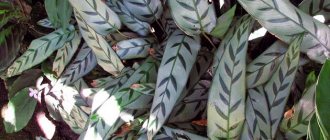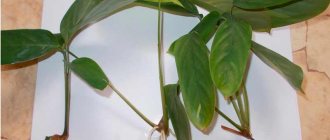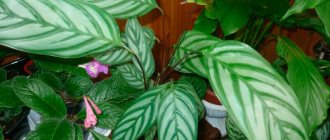Photo
You can clearly see Calathea “Medallion” in the photo below:
Home care
Let’s take a closer look at the rules for caring for Calathea “Medallion” at home.
Where is the best place to grow?
This variety of calathea is a delicate creature. Therefore, “Medallion” is recommended to be grown at home, in a warm, sunny room with a high level of air humidity.
It is not advisable to place a flower on a balcony or take it out into the garden in the fresh air in the summer.
Plant pruning
There is a lot of controversy about whether it is worth trimming a flower to form a more luxuriant crown or not.
REFERENCE! Calathea needs to be pruned only at the time of replanting. Otherwise, the flower may die!
When replanting from a plant, you need to cut off old and dried leaves; the roots should not be touched. Scissors (blades) that will be used for pruning must be disinfected in hydrogen peroxide.
Lighting
The plant needs sufficient lighting. The light should be soft, diffused . In summer, it is necessary to shade the flower and prevent direct sunlight from hitting it.
Sunburn damages delicate leaves, covering their surface with brown spots.
Lack of lighting can have a detrimental effect on the variegated color of the leaves - they become uniformly green and lose all their decorative effect.
In winter, Calathea "Medallion" needs additional artificial lighting.
Regular electric lamps are suitable for this, they will extend the daylight hours for the plant.
Calathea is best placed near a window facing east or west.
Temperature
This is a fairly heat-loving flower. The optimal temperature in summer is 20-24 degrees, in winter - 18-20 . It is necessary to avoid sudden changes in temperature and drafts, which Calathea cannot tolerate.
Watering
Excess and lack of watering is very harmful to the pampered beauty of Calathea. Therefore, moderation should be observed. In hot weather, watering is more abundant and is done as soon as the top layer of soil dries out. In winter - less often, about once a week.
To prevent stagnation of moisture in the pot, it is necessary to plant the flower in loose soil.
In hot weather, the plant should be irrigated frequently with warm, settled water.
REFERENCE! Like all plants of the arrowroot family, Calatheas are adherents of high air humidity. Therefore, in the summer, it is advisable to place a flowerpot with a flower on a tray with wet expanded clay drainage!
Planting and replanting
The key to healthy growth of Calathea “Medallion” and its abundant flowering is a well-chosen substrate.
Experienced flower growers recommend the following composition:
- leaf soil - 2 hours;
- sand - 1 hour;
- peat - 2 hours.
To make the soil more loose, you can add small pieces of charcoal to the soil.
A layer of expanded clay drainage is placed at the bottom of the pot.
Frequent replanting harms Calathea.
Adult plants are replanted every 2 years, young plants need annual soil replacement.
Replant the flower very carefully, trying not to damage the root system.
It is advisable to use the “transfer method” (the old earthen ball around the roots is not destroyed, but placed in a new flowerpot, the voids around are sprinkled with fresh substrate).
The pot should be proportionate to the root system. A container that is too large can cause the soil mixture to sour and the roots to rot.
The most suitable time for transplantation is late spring.
REFERENCE! The soil for replanting calathea must be free of lime! This must be taken into account when purchasing a ready-made mixture in a store.
Reproduction
Calathea can be propagated in 3 ways:
- By dividing the rhizome .
This method is usually used when replanting a plant. The rhizome is divided into several parts using a knife or by hand. It is necessary that each shoot has several leaves and roots. After division, each shoot is planted in light soil consisting of peat and sand (1:1). The pots are covered on top with a plastic bag or glass jar to create a greenhouse effect and placed in a warm place. Remove the coverings after the first leaves appear. - By cuttings .
The propagation method using stem cuttings is most often used. To do this, cuttings approximately 12-15 cm long with one node and several leaves are placed in a sand-peat mixture (1:1) and placed in a warm place, covered with polyethylene or a jar on top. The cut of the cuttings must be sprinkled with activated carbon to avoid rotting. The coverings are removed after the plant has rooted. - Seeds. Calathea can be propagated using seeds.
To do this, the seeds are placed on the surface of the soil, pressed down with glass and left for several weeks until germination.From time to time the glass is raised for ventilation. Germinated seeds are placed deeper into the soil (1 cm).
The emerging seedlings are planted separately in small pots.
This method is quite complicated, especially for beginner flower growers. Seeds do not always sprout, many seedlings are weak and die, so it is better to use the two previous methods of Calathea propagation.
Fertilizer
The plant needs feeding. Liquid fertilizer for deciduous and ornamental plants is suitable for this. Calathea is fertilized in the spring and summer once every 10-15 days, in winter no more than once a month.
Types and varieties of calathea
The world of calathea is huge; about 300 species belong to the genus. There are many varieties of beautiful Calathea: Calathea crocata or Calathea saffron, Calathea varshevich, Calathea lancifolia, Calathea rufibarba, Calathea makoya. All types of calathea will undoubtedly delight fans of wildlife.
Rufibarba
Calathea rufibarba
Calathea rufibarba is a branched, low bush. The leaves of the plant are satiny, narrow, with a slightly wavy texture, emerald green above, lilac-pink below. The cuttings and the back side of the leaves are covered with a red-lemon down. Calathea rufibarba does not tolerate spraying.
Dottie
Calathea dotti
The species has oval-shaped leaves, large and slightly pointed. The foliage is decorated with an expressive pattern, as if another leaf is depicted with purple contours on an emerald leaf, only smaller.
Crocata
Calathea crocata or saffron calathea
Calathea crocata or saffron calathea attracts with amazing, noticeable flowers. Magical orange-hued inflorescences on purple stems resemble flames. Calathea crocata is an elegant plant that, in addition to wonderful flowers, has luxurious foliage. Malachite, oval-shaped leaves have wavy edges and a coffee-colored lower surface. Flowering begins in January and lasts at least 4 months.
Calathea saffron is the most demanding species to care for, but its splendor impresses even the most experienced plant lover. Representatives of this species do not tolerate division well, require humidity control, and do not tolerate drafts. Calathea saffron prefers acidified soil and grows well in a double pot.
Striped
Calathea striped or zebrina
Calathea striped or zebrina is a plant up to 80 cm high. Calathea is a colorful indoor plant. The leaves are up to 40 cm long, large, velvety, ovoid, with a purplish hue below. On the emerald upper surface of the leaf, nature draws stripes and spots that form a symmetrical pattern reminiscent of the colors of a zebra. Striped calathea pleases with lilac or snow-white inflorescences.
Flamestar
Calathea Flamestar
In the middle of the leaf blade, representatives of this species have a pattern with wavy edges, which gives the impression that the leaves are on fire.
Tasmania
Calathea crocata TASSMINIA
Plants of this species captivate gardeners with their exquisite orange-hued flowers. The leaves of specimens of the Tasmania species are attractive and grooved. The tropical charmer thrives in conditions of high humidity.
Majestic White Star
Calathea Majestic White Star
The leaves of Calathea Majestic White Star are shaped like a star. The edges of the leaves are dark olive in color, and the pattern coming from the center has a bright snow-white hue.
Triostar
Calathea Triostar
Calathea Triostar is distinguished by long and narrow leaves. The pattern is not very interesting; it consists of pale stripes arranged in a chaotic manner on an olive-green leaf. On the back side, the surface of the leaf blade is bright crimson, and the pattern seems to be copied from the outer surface.
Louise
Calathea Louise
The homeland of the Calathea Louise species is Brazil. The leaves of the indoor plant have a pattern consisting of dark and light green stripes. The leaves below are lilac or crimson in color.
Bachema
Calathea bachema
Calathea bahema is a low-demanding species native to the jungles of Brazil, with dense, pointed leaves with a striking silvery-pistachio pattern. The leaves of this type of calathea are narrow, long, lance-shaped, up to 40 cm long. The flowers form inflorescences shaped like a spike. Bahema calathea has flowers that are not as bright as those of the saffron calathea, but quite attractive for connoisseurs of tropical crops.
Lansifolia
Calathea lancifolia
Calathea lancifolia is a small, but quite important plant species for gardeners. In the expanses of the Brazilian tropics, Calathea lancifolia grows under conditions of stable temperatures and high humidity. These parameters must be created and maintained when growing crops at home. The height of the plant can reach 80 cm. The flowers are snow-white or pink. The leaves are long, thin, malachite in color, with dark spots located along the midrib. The back side of the leaf blade of Calathea lancifolia is painted in a crimson-purple color.
Queen of Maui
Calathea queen maui
The leaves of specimens of this species are pale, but in the center a pattern reminiscent of a green ear is shaded in a soft olive color.
Wonderful
Calathea wonderful (lanceolate)
Calathea remarkable or Calathea lanceolate is a herbaceous plant up to 70 cm high. The leaves of the plant are 27 cm long, lanceolate, with a convex central vein and waves on the sides. The malachite stalk is covered with soft fibers, the surface of the leaf is strewn with dark olive wide lines and ovals. Representatives of this species grow rapidly and are relatively capricious.
Medallion
Calathea medallion
Calathea medallion grows in Brazil. It reaches a height of 40 cm. The leaves are oval, malachite, with silver and purple spots. The back side of the leaf is blueberry-colored.
Makoya
Calathea makoya
Calathea macoya is a plant up to 50 cm high, common in the hot Brazilian jungle. The leaves of the crop are oval-shaped, shiny, satiny, variegated, decorated with a dark stripe along the edge. The pattern on the surface of the leaf forms dark green or pink stripes extending from the central vein. Calathea makoya is one of the most famous species: you cannot pass by such a rare beauty of a plant, because it, like a magnet, attracts attention to itself.
Mix
Calathea mix
Calathea mix resembles the Zebra species. The difference is that the pattern of representatives of the Calathea mix species consists of alternating dull and light green stripes.
Varshevich
Kalathea Varshevich
Calathea Varshevich is a large bush. The leaves are oval-shaped, the surface is delicate, silky. The color of the leaf on the upper side is dark olive, the back side is crimson. The inflorescences are white or milky.
Decorated
Calathea sanderiana or ornate
Calathea sanderiana or ornata is native to the forests of Colombia. This is a miniature plant with inflorescences shaped like a spike, snow-white or purple corollas, growing up to 6-8 cm in length. Calathea sanderiana has a lemon green leaf surface that is covered in narrow pink wide lines. The leaves are oval, lanceolate, up to 20 cm long.
Orbifolia
Calathea orbifolia
Calathea orbifolia has original wavy large leaves that resemble a fan. The color of the leaves is dark malachite, the surface is decorated with light transverse stripes.
Lubbers
Calathea lubbersa
Calathea lubbersa is a tall plant with semicircular leaves. The leaves are distinguished by a variegated pattern that lacks symmetry: there are bright lemon-yellow streaks on a dark green background.
Network or mosaic
Calathea mosaic network
Calathea mosaic network is a plant with large, fleshy, heart-shaped or spear-shaped leaves. This species is distinguished by its unusual leaf color. The ornamentation on their surface consists of tiny rectangular patterns, empty or painted inside, which resemble a mosaic panel. The main color of the leaf surface is light, and the lines are bright green or light brown. The patterns are formed by crossing the veins, thereby creating a marvelous ornament. If you carefully examine the surface of the sheet, then the seemingly chaos in the distribution of the pattern at first glance has a clear structure, as if a child were drawing, trying to maintain equal spaces between the particles.
Specimens of this species tolerate the cold season well and are not too picky about humidity and lighting.
Litze
Calathea litze
Calathea litze is a plant from the sultry forests of Brazil, forming dense wilds in its homeland up to 60 cm high. The leaves are slightly wavy, not large, up to 15 cm long. The top surface of the leaf is green with a silvery steel tint and dark olive wide lines, the back side of the leaf crimson-violet color. The ornament on the surface of the leaves is in the form of a straight line, from which, on both sides, short, parallel lines of dark and light shades of green, alternating with each other, extend at an angle. The drawing is located on both sides of the sheet. Calathea Litze flowers form snow-white inflorescences shaped like a spike.
Colorized
Calathea painted
Calathea painted is a plant with leaves up to 20 cm in length. The upper side of the leaf is decorated with an original pattern: a dark middle with symmetrical stripes, a light stripe along the edge and a light midrib.
Leopard print
Calathea leopardis
A plant reaching a height of 50 cm. The leaves are lanceolate-shaped, up to 15 cm long. On top, the leaves are light turquoise in color with dark green elongated streaks connected to the midrib of the leaf. Lemon flowers form spike-shaped inflorescences.
Veitch
Calathea vecha or vicha
A plant reaching a height of 1 meter. The leaves are semicircular, up to 30 cm long, up to 10 cm wide, thick, satiny, tobacco green. The top of the leaf has lemon-green stripes, the back side has lemon-colored stripes on a crimson background. White flowers are collected in spike-shaped inflorescences.
Diseases
The appearance of brown spots on the leaves
This usually happens for two reasons: sunburn and waterlogging of the soil. It is advisable to shade the calathea and change the watering regime.
Leaves dry and curl
Drought, insufficient watering, low air humidity . You should spray the plant more often with warm and settled water, since cold and hard water can also cause dry edges on the leaf blade.
Dried leaves must be removed from the flower. Dry edges also need to be trimmed, very carefully so as not to harm the living part of the leaf.
If the flower is completely dry, do not rush to throw it away, remove the roots from the pot and inspect them.
If the roots are fresh and healthy, transplant them into a new container, water the soil and after a while new shoots will appear.
Dried and curled leaves also indicate thrips infestation..
You need to carefully examine the inside of the sheet. If a parasite is detected, treat the plant with any insecticidal solution.
The leaves are turning yellow
The light in the room is too bright or the plant suffers from drafts. Place Calathea deep in the room and observe its behavior.
Pests
Most often, Calathea “Medallion” is susceptible to attack by spider mites and thrips. The appearance of these harmful insects provokes excessively dry air in the room. Signs of damage can be seen with the naked eye:
- Spider mite - a large amount of thin white cobwebs appear on the leaves, the plant withers and withers, its leaves fall off;
- Thrips - usually lives on the inner surface of leaf blades, eating them away from the inside. First, a light spot appears on the surface of the leaf, over time it changes color, dries, crumbles, forming a hole.
Method of combating parasites : wipe the leaves of the plant with a soap solution (water, laundry soap), then treat with any insecticide. After treatment, the flower needs to be fed (after 5-6 days).
Caring for the capricious Calathea is not easy, but all your efforts will pay off when this incredibly beautiful tropical plant blooms in your apartment.
Botanical description of the plant
The most remarkable thing about the medallion calathea is its large, oval-shaped patterned leaves. Their main tone is green. Inside each leaf, another “leaf” of dark green color with light, pink, and yellow veins is outlined in a light color; the back side of the leaf may have a purple tint.
Did you know? In the era of the ancient Greeks, baskets were woven from calathea leaves. Hence the genus name, Kalathos, meaning "basket".
Each new leaf emerges from a rosette; At first it has the shape of a tube, which gradually unfolds. Another feature of the flower’s foliage is that it changes position depending on the time of day. In the morning, the leaf plates are positioned horizontally, but in the evening they become perpendicular to the ground.
Calathea does not bloom profusely. The flowers appear small, inconspicuous, white or cream in color. The seeds for plant propagation ripen in them.
| Root system | branched, superficial |
| Stem | absent |
| Leaf Shape | oval |
| Leaf color | green with patterns |
| Flower shape | funnel-shaped, terry |
| Flower color | white, cream |











